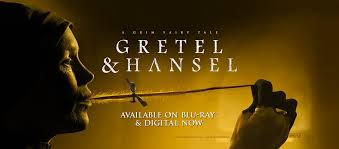
 (3.5 / 5)
(3.5 / 5)
With Gretel and Hansel, Oz Perkins retells the famous Grimms’ tale centreing it on Gretel’s ability to survive in a hostile world and overcome the temptation of evil. One should not be fooled by the title and the focus on Gretel and believe that it is a feminist rendering of the tale. The film hasn’t got an ounce of feminism or women’s empowerment. On the contrary, it is infused with the traditional misogynistic tropes of mad women and witches as women who kill children, including their own. It is not a misogynistic film either, thanks to a pervasive ambiguity, a clever weaving together of the stories of its protagonists, and subtle acting.
Faced with poverty and starvation, the mother of Gretel and Hansel turns mad and kicks them out. There begins Gretel’s journey of growing up and taking responsibility for herself and her little brother. She acts as a mother towards Hansel, protecting him from danger until Hansel’s hunger leads them inside the house of the witch. Gretel is at first wary of the hospitality of the witch. She becomes seduced by the witch’s knowledge and power. The witch teaches her magic, but it is a dark magic that requires sacrifice. The witch tells Gretel that she sacrificed her own children and asks Gretel to sacrifice Hansel to gain power.
Historical scholarship has shown that women victims of witch hunts were often those who did not conform to patriarchal norms and fulfil their roles as dutiful wives and daughters. Louise Jackson’s research on the Suffolk witch trials of 1645 shows that these were unmarried women, widows who lived alone, women suffering from depression, women who were not as submissive as they were meant to be.
The type of crimes of which the women were accused mirrored in reverse the tasks imposed by their social role of mothers and wives. As mother and wives, they were meant to feed, nurture, heal, and give birth. Thus, they were accused of poisoning, infanticide, harming, and of death. The witch is the opposite of the good wife and mother. It was not religious zealotry what motivated the witch-hunt, rather the systematic controlling of women. The pressure was so high that women convinced themselves that they were indeed witches and confessed to being a witch.
The mythical figure of the witch is constructed in opposition to the good wife and mother. She is dangerous and evil because she is not under the control of male authority. In the 1890s, as the figure of the New Woman begins to emerge in fiction and art (think Gustav Klimt), the witch and the female vampire are presented as strong in their sexuality, though largely still for the gaze of men. One of the central features of how women have been portrayed, especially in horror stories, is their dangerous power, which comes from their body, its ability to seduce, to give life, and thus destine us to death. Life is the beginning of death.
The film balances well the allure of the dark power of the witch with Gretel’s attempt at being responsible for life. It is, however, full of allusions and short of clear intent. The cinematography (by Galo Olivares) is slick without indulging in the aestheticism so prevalent in today’s cinema. Sophia Lillis, as Gretel is excellent, though it is Alice Krige, as the haggard-witch, who steals the show. The slow pace makes the film suggestive and subtle for most part. Alas, in the final act the writing (by Rob Hayes) turns artificial and wants to make a point quickly. It assumes a moralistic tone and falls for a simplistic triumph of good over evil. It’s as if the male authors couldn’t help but restoring order.

One thought on “Review Gretel and Hansel by Eva Marloes”
-
Pingback: She Will - a review by Eva Marloes - Get The Chance
Get The Chance has a firm but friendly comments policy.